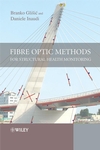 Prof. Branko Glisic and his team have recently installed a SHM system on the Streicker Bridge at Princeton University.
Prof. Branko Glisic and his team have recently installed a SHM system on the Streicker Bridge at Princeton University.The project involves instrumenting the bridge with various sensors, and to transform it into an on-site laboratory for various research and educational purposes. The main aims of the instrumentation are to face the following challenges related to SHM:
- Education gap. In spite of its importance, the culture on SHM is not yet widespread. It is often considered as an accessory activity that does not require specific skills and detailed planning, while the facts are rather the opposite.
- Real structural behavior data sets. The complete data sets collected over long-terms are needed to fully understand real structural behavior and its interaction with environment. The SHM was applied to various types of structures, but the results of monitoring are frequently only partially disclosed or incomplete, thus the knowledge basis is rather deficient.
- Change in strain patterns caused by unusual behaviors. The patterns of degradation in performance and damage in monitoring results are often “masked” by environmental influences (temperature, wind, humidity, etc.) and human-made actions (live load fluctuations) and consequently, cannot be reliably identified in controlled laboratory conditions. More real data with unusual behaviors are needed in order to develop reliable detection algorithms.
- Characterization of SHM contribution to sustainability of built environment. SHM has promising potential to contribute to the sustainability of built environment since it provides with objective information concerning the real structural performance, which can be used as an input to optimize maintenance, extend structure’s life, increase safety, decrease life-cycle costs, reduce the use of construction material, minimize adverse impact on society that may occur in case of structural deficiency, and help reducing greenhouse gas emissions.
- Besides addressing above listed challenges, the Streicker Bridge will be used for full scale testing of new SHM methods, and newly developed monitoring systems.
The SHM of Streicker Bridge is a long-term project and it will be realized in several phases. The initial phase consists of instrumentation of main span and south-east leg. The instrumentation of main span was completed on August 14, 2009 with two fiber-optic sensing technologies:
(1) Discrete Fiber Bragg-Grating (FBG) long-gage sensing technology (average strain and temperature measurements);
(2) Truly distributed sensing technology based on Brillouin Optical Time Domain Analysis (average strain and temperature measurements).
The sensors were embedded in concrete during the construction.
More information can be found on the project website.




No comments:
Post a Comment